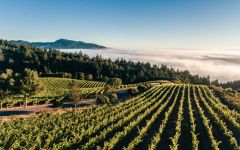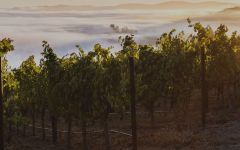Mt. Brave Cabernet Franc 2018
-
Jeb
Dunnuck -
James
Suckling -
Robert
Parker



Product Details
Your Rating
Somm Note
Winemaker Notes
Incredibly focused and defined, this pure Cabernet Franc showcases aromas of black tea, boysenberry, and anise. Loaded with dense fruit and spice on the palate, the full-bodied wine has beautifully balanced acidity and ripe, uber-fine tannins. Stunning out of the gate, this wine should provide cellaring rewards for years to come.
Professional Ratings
-
Jeb Dunnuck
Another beautiful wine in this lineup is the 2018 Cabernet Franc, which is 100% varietal and spent 22 months in 80% new French oak. Its deep purple hue is followed by a rich, full-bodied, incredibly layered 2018 offering beautiful cassis and mulberry fruit, notes of tobacco, dried flowers, and chocolate, ultra-fine tannins, no hard edges, and a great finish. This remarkable 2018 should be snatched up by readers, as it represents a smoking value!
-
James Suckling
A super intense and dense palate of blackberry with hints of chocolate. Full-bodied with density and purity. Long and powerful. Tight and reserved, but telling you it has so much there. Drink after 2024.
-
Robert Parker's Wine Advocate
Made from 100% Cabernet Franc, the 2018 Cabernet Franc Mt. Veeder was aged for 22 months in oak barrels, 80% new. Deep garnet-purple colored, the nose delivers fragrant, perfumed notes of black and red cherries, mulberries and black raspberries with hints of lavender, pencil shavings and cinnamon stick. Full-bodied, the decadently fruited palate has beautifully ripe, fine-grained tannins framing the black fruit, red berry and floral layers, finishing long and graceful.
Other Vintages
2019-
Wine
Spectator -
Jeb
Dunnuck -
James
Suckling
-
Robert
Parker -
James
Suckling -
Jeb
Dunnuck -
Wine
Enthusiast






Mt. Brave is a tribute to the pioneering spirit of those who settled the rugged terrain of Mt. Veeder during the 1800s and an homage to the Wappo Indians, "the brave ones," who were the original inhabitants of this extraordinary place. The Mt. Brave Vineyard, once the Chateau Potelle Vineyard, was established decades ago at elevations ranging from 1,400 to 1,800 feet. While Mt. Veeder is cool, Mt. Brave sits above the fog line, with morning sun warming the grapes each day. Soils are a sparse, gravelly loam. Nutrients and minerals are scant, resulting in tiny berries with concentrated and complex flavors. At harvest, small lug boxes must be carefully moved up and down the steep slopes to protect both vines and vineyard workers.

Cabernet Franc, a proud parent of Cabernet Sauvignon, is the subtler and more delicate of the Cabernets. Today Cabernet Franc produces outstanding single varietal wines across the wine-producing world. Somm Secret—One of California's best-kept secrets is the Happy Canyon appellation of Santa Barbara. Here Cabernet Franc shines as a single varietal wine or in blends, expressing sumptuous fruit, savory aromas and polished tannins.

Centered at the peak for which it is named, Mount Veeder is Napa’s largest sub-AVA. But even though the entire appellation spreads over 16,000 acres, vineyards cover a mere 1,000. Scattered among Douglas firs and bristlecone pines, Mount Veeder vineyards extend south from the upper elevations of the Mayacamas Mountains—the highest point at 2,400 feet—to the border of the Carneros region. Less than 25 wineries produce wine from Mount Veeder fruit.
Winemaking began early in this appellation. In 1864, Captain Stelham Wing presented the first Mount Veeder wine to the Napa County Fair; it came from today’s Wing Canyon Vineyard. Prohibition, of course, halted winemaking and viticulture wasn’t revitalized until the founding of Mayacamas Vineyards in 1951 and Bernstein Vineyards in 1964.
The Bernstein Vineyards was actually home to the first Petit Verdot in California, planted in 1975. Today most of the Petit Verdot in Napa Valley originates from this vineyard.
Rocky volcanic clay and ancient seabed matter dominate Mount Veeder soils—perfect for Bordeaux varieties. Cabernet Sauvignon, Merlot, Malbec, Cabernet Franc and Petit Verdot enjoy spectacular success. These varieties produce wines rich in brambly blackberry and black cherry fruit with herbal and floral aromatics. Structures are moderate to assertive and wines have great staying power.
Chardonnay from Mount Veeder is lush, full and balanced mineral and fresh citrus flavors.
